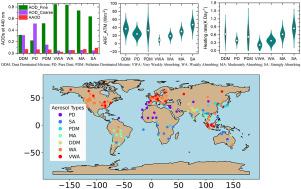基于气溶胶机器人网络(AERONET)数据的全球气溶胶类型分类及其辐射效应
IF 3.7
2区 环境科学与生态学
Q2 ENVIRONMENTAL SCIENCES
引用次数: 0
摘要
本研究基于气溶胶机器人网络(AERONET) 3.0版和2.0级反演产品提供的粒子线性去极化比(PLDR)和单散射反照率(SSA),对全球气溶胶进行了分类,这些产品位于六大洲的171个AERONET站点。目前的方法可以利用PLDR和SSA有效地区分粉尘和非粉尘气溶胶。这些选择的地点包括优势气溶胶类型,如纯粉尘(PD)、粉尘主导混合物(DDM)、污染主导混合物(PDM)、极弱吸收(VWA)、强吸收(SA)、中等吸收(MA)和弱吸收(WA)。与黑碳相关的生物质燃烧气溶胶被指定为WA、MA和SA的组合。关键的重要发现表明,北非地区的站点主要受PD的影响,而南亚站点则以DDM以及粉尘和污染气溶胶的混合物为特征。位于欧洲和北美的城市和工业化地区以VWA、WA和MA气溶胶为特征。热带地区,包括南美洲、东南亚和南部非洲容易发生森林和生物质燃烧的地区,主要是SA气溶胶。该研究进一步考察了辐射强迫对不同气溶胶类型的影响。在气溶胶类型中,SA和VWA对大气强迫的贡献分别最高(30.14±8.04 Wm−2)和最低(7.83±4.12 Wm−2)。因此,发现大气升温速率最高的是SA (0.85 Kday−1),最低的是VWA气溶胶(0.22 Kday−1)。目前的研究提供了一份关于六大洲不同气溶胶类型的气溶胶光学、微物理和辐射特性的综合报告。本文章由计算机程序翻译,如有差异,请以英文原文为准。

Classification of global aerosol types and its radiative effects using Aerosol Robotic Network (AERONET) data
The present study performed classification global aerosols based on particle linear depolarization ratio (PLDR) and single scattering albedo (SSA) provided from AErosol RObotic NETwork (AERONET) Version 3.0 and Level 2.0 inversion products of 171 AERONET sites located in six continents. Current methodology could distinguish effectively between dust and non-dust aerosols using PLDR and SSA. These selected sites include dominant aerosol types such as, pure dust (PD), dust dominated mixture (DDM), pollution dominated mixture (PDM), very weakly absorbing (VWA), strongly absorbing (SA), moderately absorbing(MA), and weakly absorbing (WA). Biomass-burning aerosols which are associated with black carbon are assigned as combinations of WA, MA and SA. The key important findings show the sites in the Northern African region are predominantly influenced by PD, while south Asian sites are characterized by DDM as well as mixture of dust and pollution aerosols. Urban and industrialized regions located in Europe and North American sites are characterized by VWA, WA, and MA aerosols. Tropical regions, including South America, South-east-Asia and southern African sites which prone to forest and biomass-burning, are dominated by SA aerosols. The study further examined the impacts by radiative forcing for different aerosol types. Among the aerosol types, SA and VWA contribute with the highest (30.14 ± 8.04 Wm−2) and lowest (7.83 ± 4.12 Wm−2) atmospheric forcing, respectively. Consequently, atmospheric heating rates are found to be highest by SA (0.85 K day−1) and lowest by VWA aerosols (0.22 Kday−1). The current study provides a comprehensive report on aerosol optical, micro-physical and radiative properties for different aerosol types across six continents.
求助全文
通过发布文献求助,成功后即可免费获取论文全文。
去求助
来源期刊

Atmospheric Environment
环境科学-环境科学
CiteScore
9.40
自引率
8.00%
发文量
458
审稿时长
53 days
期刊介绍:
Atmospheric Environment has an open access mirror journal Atmospheric Environment: X, sharing the same aims and scope, editorial team, submission system and rigorous peer review.
Atmospheric Environment is the international journal for scientists in different disciplines related to atmospheric composition and its impacts. The journal publishes scientific articles with atmospheric relevance of emissions and depositions of gaseous and particulate compounds, chemical processes and physical effects in the atmosphere, as well as impacts of the changing atmospheric composition on human health, air quality, climate change, and ecosystems.
 求助内容:
求助内容: 应助结果提醒方式:
应助结果提醒方式:


